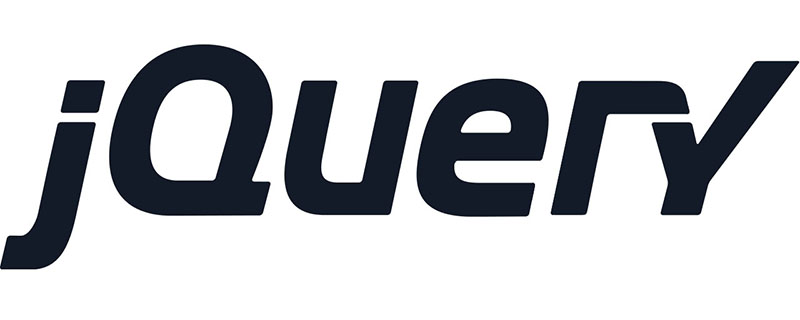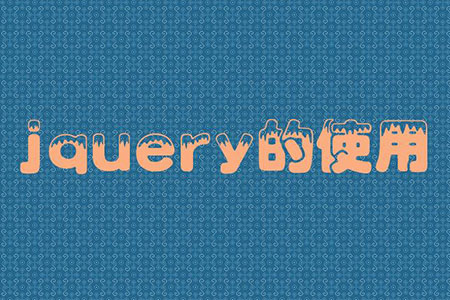How to use jquery
How to use jquery: First load the jquery file through CDN loading or local loading of files; then execute the jQuery code through the jquery file.

The operating environment of this article: Windows 7 system, Dell G3 computer, jquery version 3.2.1.
How to use jquery? This article will introduce to you what is jquery? Why use jquery? How to use jquery? Let everyone know how to use jquery, I hope it will be helpful to you.
What is jQuery?
jQuery is not a language, but it is well-written JavaScript code. It is a fast and concise JavaScript library that simplifies HTML document traversal, event handling, animation and Ajax Interactive for rapid web development.
Why choose jQuery?
jQuery is a very compact and well-written JavaScript code that improves developer productivity by writing very small amounts of code so that they can implement critical UI functionality.
The advantages of jQuery are:
1. There is no need to learn a new syntax to use jQuery, it is enough to understand simple JavaScript syntax.
2. The code is simple and clear, and complex functions can be implemented without writing multiple lines of code.
3. Helps improve application performance.
4. It helps develop web pages that are compatible with most browsers.
5. It helps to implement key UI-related functions without writing hundreds of lines of code.
How to use jQuery?

#1. Load the jQuery file
jQuery usually comes as a single JavaScript file that contains everything jQuery does out of the box. It can be included in a web page in the following ways:1), load local jQuery file
First you need todownload the jQuery file to the local, jQuery JavaScript files can be downloaded from the jQuery official website, address: http://www.jquery.com.
Then load jQuery files<script type="text/javascript" src="jQuery-1.4.1-min.js"></script>
2), load jQuery from CDN
What is CDN?
CDN stands for Content Distribution Network, also known as Content Delivery Network. It is a group of computers placed at various points connected to the replica network containing data files to maximize bandwidth. In a CDN, clients access a copy of the data closer to the client's location, rather than all clients accessing it from one specific server. This helps achieve better data retrieval performance on the client side.There are two main CDNs available for hosting jQuery files:
<script type="text/javascript" language="Javascript" src="http://ajax.aspnetcdn.com/ajax/jquery/jquery-1.4.1.min.js"></script>
<script type="text/javascript" language="Javascript" src="https://ajax.googleapis.com/ajax/libs/jquery/1.4.4/jquery.min.js"> </script>
Benefits of loading jQuery from CDN:
1. Since there is no need to download the jQuery file, the page loads faster2. Load jQuery files from the server, thus saving bandwidth 3. Scalable, usually CDNs place these files on servers located in different geographical locations around the world so that they load faster, so no matter where the user is browsing page, and your application will run normally.Note:
Generally, loading jQuery from CDN and loading jQuery files from local area must be written in order to prevent loading jQuery files. CDN is not available. Therefore, you can write the following lines of code:<!-- START - jQuery Reference -->
<script type="text/javascript" language="Javascript"
src="http://ajax.aspnetcdn.com/ajax/jquery/jquery-1.4.1.min.js"></script>
<script type='text/javascript'>//<![CDATA[
if (typeof jQuery == 'undefined') {
document.write(unescape("%3Cscript
src='/Script/jquery-1.4.1.min.js' type='text/javascript' %3E%3C/script%3E"));
}//]]>
</script>
<!-- END - jQuery Reference -->2. Execute jQuery code
We may have two ways to execute jQuery code. 1. When the page loads, execute the jQuery code:<script language="javascript" type="text/javascript">
$(function () {
$("#div1").css("border", "2px solid green");
});
</script><script language="javascript" type="text/javascript">
$("#div1").css("border", "2px solid green");
</script><script language="javascript" type="text/javascript">
$(document).ready(function () {
$("#div1").css("border", "2px solid green");
});
</script>这是执行jQuery的更好,更安全的方法。这样可以确保只有在浏览器中加载完整页面时才会执行jQuery代码,因此可以放心,用户不会在页面上看到任何不需要的行为。
总结:以上就是本篇文章的全部内容,希望能对大家的学习有所帮助。
The above is the detailed content of How to use jquery. For more information, please follow other related articles on the PHP Chinese website!

Hot AI Tools

Undresser.AI Undress
AI-powered app for creating realistic nude photos

AI Clothes Remover
Online AI tool for removing clothes from photos.

Undress AI Tool
Undress images for free

Clothoff.io
AI clothes remover

Video Face Swap
Swap faces in any video effortlessly with our completely free AI face swap tool!

Hot Article

Hot Tools

Notepad++7.3.1
Easy-to-use and free code editor

SublimeText3 Chinese version
Chinese version, very easy to use

Zend Studio 13.0.1
Powerful PHP integrated development environment

Dreamweaver CS6
Visual web development tools

SublimeText3 Mac version
God-level code editing software (SublimeText3)

Hot Topics
 1386
1386
 52
52
 Detailed explanation of jQuery reference methods: Quick start guide
Feb 27, 2024 pm 06:45 PM
Detailed explanation of jQuery reference methods: Quick start guide
Feb 27, 2024 pm 06:45 PM
Detailed explanation of jQuery reference method: Quick start guide jQuery is a popular JavaScript library that is widely used in website development. It simplifies JavaScript programming and provides developers with rich functions and features. This article will introduce jQuery's reference method in detail and provide specific code examples to help readers get started quickly. Introducing jQuery First, we need to introduce the jQuery library into the HTML file. It can be introduced through a CDN link or downloaded
 How to use PUT request method in jQuery?
Feb 28, 2024 pm 03:12 PM
How to use PUT request method in jQuery?
Feb 28, 2024 pm 03:12 PM
How to use PUT request method in jQuery? In jQuery, the method of sending a PUT request is similar to sending other types of requests, but you need to pay attention to some details and parameter settings. PUT requests are typically used to update resources, such as updating data in a database or updating files on the server. The following is a specific code example using the PUT request method in jQuery. First, make sure you include the jQuery library file, then you can send a PUT request via: $.ajax({u
 In-depth analysis: jQuery's advantages and disadvantages
Feb 27, 2024 pm 05:18 PM
In-depth analysis: jQuery's advantages and disadvantages
Feb 27, 2024 pm 05:18 PM
jQuery is a fast, small, feature-rich JavaScript library widely used in front-end development. Since its release in 2006, jQuery has become one of the tools of choice for many developers, but in practical applications, it also has some advantages and disadvantages. This article will deeply analyze the advantages and disadvantages of jQuery and illustrate it with specific code examples. Advantages: 1. Concise syntax jQuery's syntax design is concise and clear, which can greatly improve the readability and writing efficiency of the code. for example,
 How to remove the height attribute of an element with jQuery?
Feb 28, 2024 am 08:39 AM
How to remove the height attribute of an element with jQuery?
Feb 28, 2024 am 08:39 AM
How to remove the height attribute of an element with jQuery? In front-end development, we often encounter the need to manipulate the height attributes of elements. Sometimes, we may need to dynamically change the height of an element, and sometimes we need to remove the height attribute of an element. This article will introduce how to use jQuery to remove the height attribute of an element and provide specific code examples. Before using jQuery to operate the height attribute, we first need to understand the height attribute in CSS. The height attribute is used to set the height of an element
 jQuery Tips: Quickly modify the text of all a tags on the page
Feb 28, 2024 pm 09:06 PM
jQuery Tips: Quickly modify the text of all a tags on the page
Feb 28, 2024 pm 09:06 PM
Title: jQuery Tips: Quickly modify the text of all a tags on the page In web development, we often need to modify and operate elements on the page. When using jQuery, sometimes you need to modify the text content of all a tags in the page at once, which can save time and energy. The following will introduce how to use jQuery to quickly modify the text of all a tags on the page, and give specific code examples. First, we need to introduce the jQuery library file and ensure that the following code is introduced into the page: <
 Use jQuery to modify the text content of all a tags
Feb 28, 2024 pm 05:42 PM
Use jQuery to modify the text content of all a tags
Feb 28, 2024 pm 05:42 PM
Title: Use jQuery to modify the text content of all a tags. jQuery is a popular JavaScript library that is widely used to handle DOM operations. In web development, we often encounter the need to modify the text content of the link tag (a tag) on the page. This article will explain how to use jQuery to achieve this goal, and provide specific code examples. First, we need to introduce the jQuery library into the page. Add the following code in the HTML file:
 How to tell if a jQuery element has a specific attribute?
Feb 29, 2024 am 09:03 AM
How to tell if a jQuery element has a specific attribute?
Feb 29, 2024 am 09:03 AM
How to tell if a jQuery element has a specific attribute? When using jQuery to operate DOM elements, you often encounter situations where you need to determine whether an element has a specific attribute. In this case, we can easily implement this function with the help of the methods provided by jQuery. The following will introduce two commonly used methods to determine whether a jQuery element has specific attributes, and attach specific code examples. Method 1: Use the attr() method and typeof operator // to determine whether the element has a specific attribute
 Understand the role and application scenarios of eq in jQuery
Feb 28, 2024 pm 01:15 PM
Understand the role and application scenarios of eq in jQuery
Feb 28, 2024 pm 01:15 PM
jQuery is a popular JavaScript library that is widely used to handle DOM manipulation and event handling in web pages. In jQuery, the eq() method is used to select elements at a specified index position. The specific usage and application scenarios are as follows. In jQuery, the eq() method selects the element at a specified index position. Index positions start counting from 0, i.e. the index of the first element is 0, the index of the second element is 1, and so on. The syntax of the eq() method is as follows: $("s




